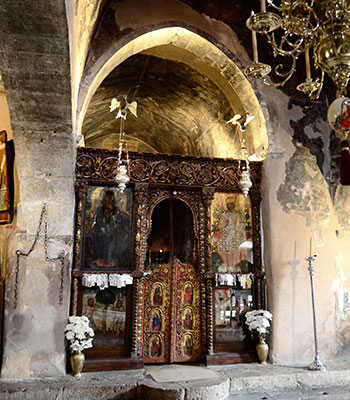 Panagia Kera or Kardiotissa is a historical monastery and is located 50 kms southeast of Heraklion, just before arriving to Kera village which is named after the monastery. During WW2 this monastery was used by the Greek Liberation Army.
Panagia Kera or Kardiotissa is a historical monastery and is located 50 kms southeast of Heraklion, just before arriving to Kera village which is named after the monastery. During WW2 this monastery was used by the Greek Liberation Army.
The Monastery is dedicated to the Nativity of the Theotokos (Nativity of Mary) and it is one of the most important monasteries of Crete. Today it is a nunnery and accommodates 6 nuns. The establishment of the monastery is associated with the miraculous icon of Virgin Mary, which is currently kept in the Church of St. Alphonsus, in Esquilino, Rome. It is an icon of Vrefokratoussa (Infant Holder), holding Jesus in her arms, on the side of her heart –that’s why it was called Kardiotissa (from the Greek word kardia, meaning heart).
Panagia Kera is the other icon that is associated with miracles. It is currently in the monastery, dates back to 1795 and is called “Kyria Kardiotissa” (Lady of the Heart). Virgin Mary is depicted enthroned, facing the front, holding baby Jesus. According to tradition, the icon was stolen three times by the Turks and was sent to Constantinople. But every time, somehow, the icon returned to the monastery. The third time, to avoid losing the icon again, they tied it to a marble column with a thick chain. Today both the column and the chain are in the monastery. One of these times, as the icon was reaching the monastery, coming back from Constantinople, it touched a high steep rock and left its “mark” that can still be seen today. Nowadays, this spot is called “Impression”.
The most ancient wall painting in the Catholicon dates back to the second decade of the 14th century. Panagia Kera went through a lot of adventures and destructions, while it was also a bulwark in the struggle for liberation. Its location was a great contribution to that, as it is a natural gate between the prefectures of Heraklion and Lassithi. When it was established is still unknown. Most probably, though, it is a building of the 2nd Byzantine Period, 921-1211 AD. The oldest reference to it is on a record of 1333, when it was a fiefdom of the Latin Patriarchate of Constantinople. Panagia Kera was renovated due to the family of Maganaris (17th century). Today, from the original fort-like monastery, the only thing that remains is the Catholicon, which appears to have been built in four construction phases.
The original single-nave church of Virgin Mary is used today as a sanctuary and is separated from the rest of the place with an iconostasis. The exact time of the construction of the north chapel is unknown. The first narthex to the west has got a three-way layout. On the west side of it there is a second narthex, the inner part of which is topped with an arch that presents a transverse layout in relation to the original space, without supporting arcs.
The oldest wall painting is maintained in today’s sanctuary (original church). On the quadrant of the alcove there is a depiction of Vrefokratoussa (Infant Holder), on the alcove the Co-Officiating Hierarchs, while on the frieze of the east wall, the “Annunciation”. On the arch of the original church, there is the “Ascension of Jesus” and on the arch of the main church, there are scenes from Virgin Mary’s life. In the central nave of the first narthex, the east wall is decorated with the scene of the “Assumption of Mary”. On the arch, there are scenes from the “Birth of Jesus”, “Joseph’s Dream”, “Exodus”, the “Entry into Jerusalem”, the “Betrayal of Judas”, “Christ carrying the cross”, the “Raising of Lazarus”, the “Myrrh-bearing women at the tomb of Christ”, the “Descent into Hades”, the “Candlemas”, and the “Pentecost”. On the west wall, the icons include the “Last Supper”, the “Washing of the feet” and heart-breaking scenes from the “Crucifixion”. The south nave of the first narthex is decorated with scenes from the “Judgement Day” with the “Prayer” and on a lower level, the “Epitaphios Lament” (Holy Friday Lamentation). The murals in the north nave of the first narthex were painted later on.
Architecture: Originally single-nave barrel vaulted, gradually other naves were added
Dating : 961 – 1204
Location: Kera (Arkalies – Kera village, near Krasi village)
Celebration: 8th September
Hagiography: YES
Access : Easy access from a country road
Visit Options: Winter: 8:00 - 17:00
Summer: 7:00 - 19:00